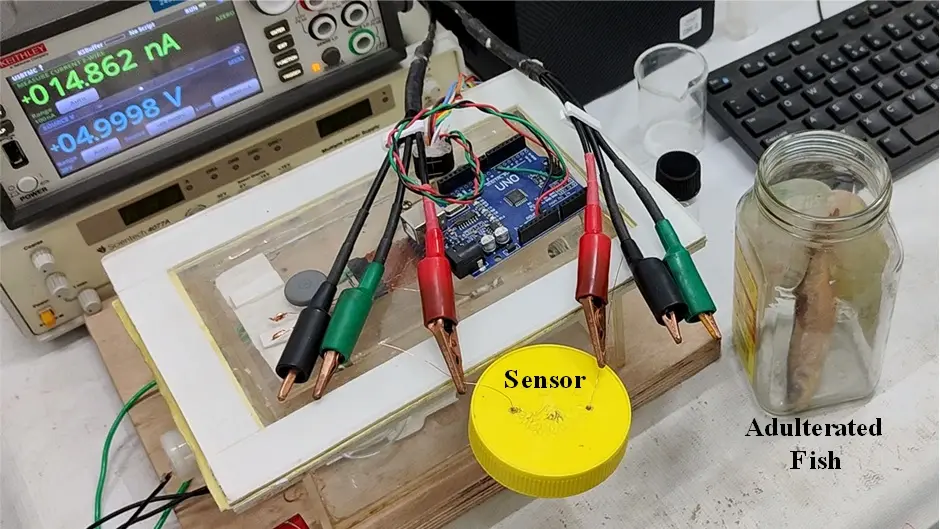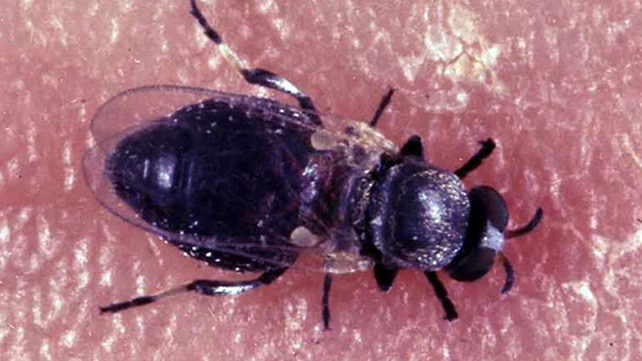About Non-invasive formaldehyde sensor
- Materials used: Tin oxide-reduced graphene oxide composite (rGO- SnO2).
- While reduced graphene oxide (rGO) has been used to detect various toxic gases and VOCs, tin oxide (SnO2) has been extensively investigated for formaldehyde detection in pristine form and by incorporating it with various compounds, including graphene, due to its high stability and high sensitivity toward low concentrations of formaldehyde.
- Process: The Graphene oxide (GO) was processed through wet chemical approach and tin oxide-reduced graphene oxide composite (rGO- SnO2) was synthesized by hydrothermal route followed by calcination of the obtained product.
- They found that the sensor made of tin oxide decorated with reduced graphene oxide effectively sensed formaldehyde vapor at room temperature.
- The sensor shows long-term stability with a low detection limit.
- A new low-cost sensor made of metal oxide nanoparticles reduced graphene oxide composite can detect formalin adulteration in fishes at room temperature in a non-invasive way.
- The research for this is supported by DST-PURSE (Promotion of University Research and Scientific Excellence).
- Existing sensors
- Commercial formalin sensors for fish are primarily electrochemical-based or colorimetric-based. Electrochemical sensors are extensively used but are expensive.
- The calorimetric sensors are less expensive. But both methods are invasive in nature.
- Issue: Low-level detection and selective detection are two major issues with these sensors.
- Significance of new sensor
- The development of 2D materials-based gas sensors has created a new avenue of effective detection of toxic vapors at room temperature.
- These sensors have the potential to detect the formalin evaporated from adulterated food products.
What is Formaldehyde?
- It is a colourless, pungent gas that is used in a variety of industrial processes, including as a preservative in some foods, commonly in fish in developing countries.
Q1) What is Promotion of University Research and Scientific Excellence (PURSE)?
It is one of the Flagship Infrastructure programs of the Department of Science and Technology, which commenced in the year 2009 exclusively for the University sector. The main objective of the scheme is to strengthen the research capacity of performing Indian Universities and provide support for nurturing the research ecosystem and strengthening the R&D base of the Universities in the country.
Source: New non-invasive formaldehyde sensor can detect adulterated fish at room temperature
Last updated on November, 2025
→ Check out the latest UPSC Syllabus 2026 here.
→ Join Vajiram & Ravi’s Interview Guidance Programme for expert help to crack your final UPSC stage.
→ UPSC Mains Result 2025 is now out.
→ UPSC Notification 2026 is scheduled to be released on January 14, 2026.
→ UPSC Calendar 2026 is released on 15th May, 2025.
→ The UPSC Vacancy 2025 were released 1129, out of which 979 were for UPSC CSE and remaining 150 are for UPSC IFoS.
→ UPSC Prelims 2026 will be conducted on 24th May, 2026 & UPSC Mains 2026 will be conducted on 21st August 2026.
→ The UPSC Selection Process is of 3 stages-Prelims, Mains and Interview.
→ UPSC Result 2024 is released with latest UPSC Marksheet 2024. Check Now!
→ UPSC Prelims Result 2025 is out now for the CSE held on 25 May 2025.
→ UPSC Toppers List 2024 is released now. Shakti Dubey is UPSC AIR 1 2024 Topper.
→ UPSC Prelims Question Paper 2025 and Unofficial Prelims Answer Key 2025 are available now.
→ UPSC Mains Question Paper 2025 is out for Essay, GS 1, 2, 3 & GS 4.
→ UPSC Mains Indian Language Question Paper 2025 is now out.
→ UPSC Mains Optional Question Paper 2025 is now out.
→ Also check Best IAS Coaching in Delhi

















